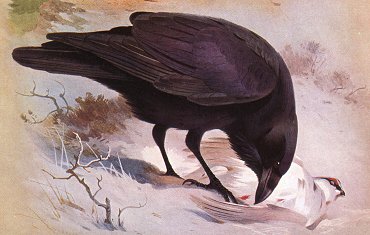
| Raven Lodge Hotel | |||||||||||||||||||||||||||||||||||||||||||||
| Home | News | Hotel | Live Music | Reviews | Raven History | Picture Gallery | Forum | Raven facts | Pub Games | Links | |||||||||||||||||||||||||||||||||||||||||||||
| Raven facts | |||||||||||||||||||||||||||||||||||||||||||||
|
|
|||||||||||||||||||||||||||||||||||||||||||||
|
To see one raven is lucky, 'tis true,
Words from an unknown ballad, they accurately express our mixed emotions about the biggest songbird and largest all black bird in the world. The Common Raven, Corvus corax, can be found around the world throughout the Northern Hemisphere. It is equally at home hawking for prey over an arroyo in the Arizonan deserts during the blistering mid-day heat, tumbling through the skies amidst the loftiest peaks in the Himalayas, or perching on a street light in urban Alaska waiting to steal its next meal from an unsuspecting human benefactor. The raven is a member of a very successful family of birds, the Corvidae, which also includes jays, magpies, and crows. Many people confuse ravens and crows, and even experienced bird watchers slip up now and then. Although ravens are considerably larger than crows, a big crow and a small raven might be a little difficult to tell apart by size alone, especially if the bird is some distance away. Ravens have larger, stouter bills than do crows, and the tip of the upper beak is more downcurved. Ravens also have shaggy throat feathers and a wedge-shaped tail, visible best when the bird is in flight. Crows' tails are more square cut. The call of the crow is a nasal caw compared to the deep, gutteral croak of the raven, although both species have extensive and varied vocal repertoires.
The raven is the king of the Corvidae birds, weight 3 pounds. It is black and has a strong beak, wing span 4 feet, length 2 feet plus, The raven can reach an age of 30-50 years. The oldest only in captivity. The raven is omnivore. The nest is built in trees, on cliffs and on power-line poles usually 15 - 30 m above the ground. They use twigs and sticks, the lining is made of animal hairs -especially from elk (moose)- Juniper bast and grass. The eggs are 4 -8 light blue and spotted. Both parents feed the nestlings who stay in the nest until they are almost full fledged when they start to walk around in the tree top. Pairs live in lifelong "marriages" and annually return to the same nests. The raven can be found in Europe, Asia and Northern America where it is common. The ravens don't move south in the vinter, they move around in wide areas to find food. The raven is a very skilful flyer, diving, flying upside down, turns somersaults and other tricks. Imitating other animal sounds, the sound of the wind and human speech are other skils. The raven is believed to be intelligent and regarded as the king of Corvidae family.  Ravens are associated with the devil in many parts of UK. In Yorkshire children were threatened with the Great Black Bird which would carry them off if they were bad.
It has been said that a baby will die if a raven's eggs are stolen. Alexander the Great was supposedly guided across the desert by two ravens sent from heaven.
The Tower of London houses ravens, and has for over 900 years. It is said that if the ravens ever leave the Tower, England will fall. Or, to be more exact, if they leave the Tower, the Tower will fall - and since the tower is (theoretically at least) tied to the crown of England, the Crown will fall - and if the Crown falls, then the Country shall fall, too.
If a raven perches on a house in Wales, it will bring prosperity to the family within.
In Scotland, a raven circling a house was said to predict the death of someone within. The god Odin, in Norse mythology, had two ravens named Thought and Memory. They would fly around all day, and in the evening they would converse with him the happenings around the world. |
|||||||||||||||||||||||||||||||||||||||||||||


